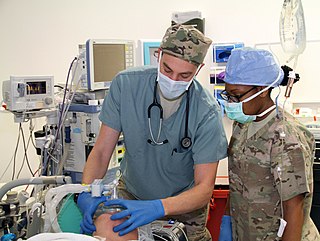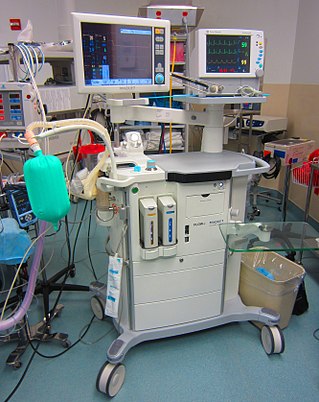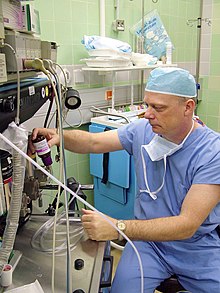
Anesthesia or anaesthesia is a state of controlled, temporary loss of sensation or awareness that is induced for medical or veterinary purposes. It may include some or all of analgesia, paralysis, amnesia, and unconsciousness. An individual under the effects of anesthetic drugs is referred to as being anesthetized.

General anaesthesia (UK) or general anesthesia (US) is a method of medically inducing loss of consciousness that renders a patient unarousable even with painful stimuli. This effect is achieved by administering either intravenous or inhalational general anaesthetic medications, which often act in combination with an analgesic and neuromuscular blocking agent. Spontaneous ventilation is often inadequate during the procedure and intervention is often necessary to protect the airway. General anaesthesia is generally performed in an operating theater to allow surgical procedures that would otherwise be intolerably painful for a patient, or in an intensive care unit or emergency department to facilitate endotracheal intubation and mechanical ventilation in critically ill patients. Depending on the procedure, general anaesthesia may be optional or required. Regardless of whether a patient may prefer to be unconscious or not, certain pain stimuli could result in involuntary responses from the patient that may make an operation extremely difficult. Thus, for many procedures, general anaesthesia is required from a practical perspective.

Anesthesiology, anaesthesiology, or anaesthesia is the medical specialty concerned with the total perioperative care of patients before, during and after surgery. It encompasses anesthesia, intensive care medicine, critical emergency medicine, and pain medicine. A physician specialized in anesthesiology is called an anesthesiologist, anaesthesiologist, or anaesthetist, depending on the country. In some countries, the terms are synonymous, while in other countries, they refer to different positions and anesthetist is only used for non-physicians, such as nurse anesthetists.

An anaesthetic machine or anesthesia machine is a medical device used to generate and mix a fresh gas flow of medical gases and inhalational anaesthetic agents for the purpose of inducing and maintaining anaesthesia.
Awareness under anesthesia, also referred to as intraoperative awareness or accidental awareness during general anesthesia (AAGA), is a rare complication of general anesthesia where patients regain varying levels of consciousness during their surgical procedures. While anesthesia awareness is possible without resulting in any long-term memory of the experience, it is also possible for victims to have awareness with explicit recall, where they can remember the events related to their surgery.

A Certified Registered Nurse Anesthetist (CRNA) is a type of advanced practice nurse who administers anesthesia in the United States. CRNAs account for approximately half of the anesthesia providers in the United States and are the main providers (80%) of anesthesia in rural America. Historically, nurse anesthetists have been providing anesthesia care to patients for over 150 years since the American Civil War and the CRNA credential came into existence in 1956. CRNA schools issue a doctorate of nursing anesthesia degree to nurses who have completed a program in anesthesia, which is 3 years in length.

A surgical technologist, also called a scrub, scrub tech, surgical technician, or operating department practitioner or operating room technician, is an allied health professional working as a part of the team delivering surgical care. Surgical technologists are members of the surgical team. The members of the team include the surgeon, surgeon's assistant, circulator nurse and anesthesia provider. They possess knowledge and skills in sterile and aseptic techniques. There are few mandatory professional requirements for surgical technologists, and the scope of practice varies widely across countries and jurisdictions. Surgical technologists attend junior colleges and technical schools, and many are trained in military schools. In the military they perform the duties of both the circulator and the scrub. The goal is for surgical technologists to be able to anticipate the next move the surgeon is going to make in order to make the procedure as smooth and efficient as possible. They do this by having knowledge of hundreds of surgical procedures and the steps the surgeon needs to take in order to complete the procedure, including the very wide range of surgical instruments they may need. Specialties can include, but are not limited to, the following: genitourinary, obstetrics and gynaecology, urology, ENT, plastics, general, orthopedics, neurology, and cardiovascular. They only work in surgical or perioperative areas and are highly specialized. Surgical technologist is the proper term for a two-year program which earns a degree in applied sciences. The profession is up and coming and highly in demand.
An advanced practice nurse (APN) is a nurse with post-graduate education and training in nursing. Nurses practicing at this level may work in either a specialist or generalist capacity. APNs are prepared with advanced didactic and clinical education, knowledge, skills, and scope of practice in nursing.
The American Society of Anesthesiologists (ASA) is an educational, research and scientific association of physicians organized to raise the standards of the medical practice of anesthesiology and to improve patient care.
In the United Kingdom, operating department practitioners (ODPs) are allied healthcare professionals who are involved in the planning and delivery of perioperative care. As the name suggests, they are primarily employed in surgical operating departments, but they may also work directly within a variety of acute clinical settings, including pre-hospital emergency care, emergency departments, intensive care units (ICUs), endoscopy suites, interventional radiology, cardiac catheter suites, obstetric theatres and reproductive medicine.
In the United States, anesthesia can be administered by physician anesthesiologists, an anesthesiologist assistant, or nurse anesthetist.
Harold Randall Griffith was a Canadian anesthesiologist and a leader in the fields of anesthesiology.

Alice Magaw was an American nurse known for her work on anesthesia. Her innovations helped lead to major advances in modern surgery and earned her the title of the 'mother of anesthesia.'
The American Association of Nurse Anesthesiology (AANA), previously named the American Association of Nurse Anesthetists, is a professional association for nurse anesthetists in the United States. The organization states that it has a membership of more than 62,000 and represents approximately 90% of CRNAs in the United States. The AANA headquarters is currently located in Rosemont, Illinois, a suburb of Chicago.
Perianesthesia nursing is a nursing specialty practice area concerned with providing nursing care to patients undergoing or recovering from anesthesia. Perianesthesia nursing encompasses several subspecialty practice areas and represents a diverse number of practice environments and skill sets.
Neurosurgical anesthesiology, neuroanesthesiology, or neurological anesthesiology is a subspecialty of anesthesiology devoted to the total perioperative care of patients before, during, and after neurological surgeries, including surgeries of the central (CNS) and peripheral nervous systems (PNS). The field has undergone extensive development since the 1960s correlating with the ability to measure intracranial pressure (ICP), cerebral blood flow (CBF), and cerebral metabolic rate (CMR).
Perioperative nursing is a nursing specialty that works with patients who are having operative or other invasive procedures. Perioperative nurses work closely with surgeons, anaesthesiologists, nurse anaesthetists, surgical technologists, and nurse practitioners. They perform preoperative, intraoperative, and postoperative care primarily in the operating theatre.
Certified anesthesiologist assistants (CAAs) are highly trained master’s degree level non-physician anesthesia care providers. CAAs are integral members of the anesthesia care team as described by the American Society of Anesthesiologists (ASA). This designation must be disambiguated from the Certified Clinical Anesthesia Assistant (CCAA) designation conferred by the Canadian Society of Respiratory Therapists. All CAAs possess a baccalaureate degree, and complete an intensive didactic and clinical program at a postgraduate level. CAAs are trained in the delivery and maintenance of all types of anesthesia care as well as advanced patient monitoring techniques. The goal of CAA education is to guide the transformation of student applicants into competent clinicians.
The following outline is provided as an overview of and topical guide to anesthesia:
Isabella Herb was an American medical pioneer in the fields of pathology and anesthesiology. Her career spanned more than half a century, ending with her retirement in 1941. She was the first woman physician to specialize in anesthesiology, and the first Mayo Clinic specialist in her areas of expertise. In 1933, Herb designed the Herb–Mueller apparatus for administering ether to patients. She was the head of the Department of Anesthesia at Presbyterian Hospital, and the first woman president of the American Association of Anesthetists.










